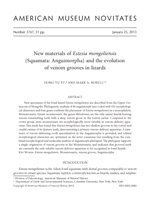New specimens of the fossil lizard Estesia mongoliensis are described from the Upper Cretaceous of Mongolia. Phylogenetic analysis of 86 anguimorph taxa coded with 435 morphological characters and four genes confirms the placement of Estesia mongoliensis in a monophyletic Monstersauria. Extant monstersaurs, the genus Heloderma, are the only extant lizards bearing venom-transmitting teeth with a deep venom grove in the rostral carina. Compared to the crown group, stem monstersaurs are morphologically more variable in venom-delivery apparatus. This study has found that Estesia mongoliensis has two shallow grooves in the rostral and caudal carinae of its dentary teeth, demonstrating a primary venom-delivery apparatus. A summary of venom-delivering tooth specialization in the Anguimorpha is provided, and related morphological characters are optimized on the strict consensus tree resulting from the combined morphological and molecular analysis of anguimorph phylogeny The phylogeny supports a single origination of venom grooves in the Monstersauria, and indicates that grooved teeth are currently the only reliable venom-delivery apparatus to be recognized in fossil lizards.
How to translate text using browser tools
25 January 2013
New Materials of Estesia mongoliensis (Squamata: Anguimorpha) and the Evolution of Venom Grooves in Lizards
Hong-Yu Yi,
Mark A. Norell

American Museum Novitates
Vol. 2013 • No. 3767
January 2013
Vol. 2013 • No. 3767
January 2013
Anguimorpha
Estesia mongoliensis
Monstersauria
venom groove




